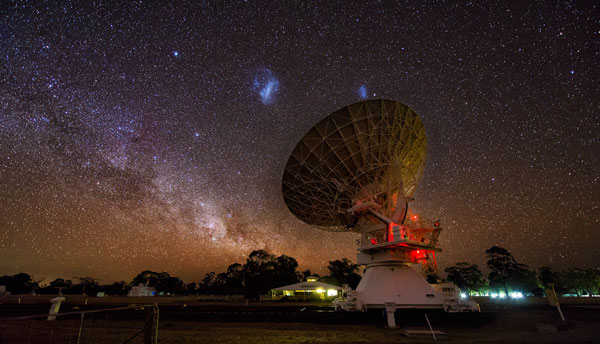A magnetic field appears to span the space between the Large and Small Magellanic Clouds, the two dwarf galaxies being consumed by our Milky Way Galaxy.
For stargazers in the Northern Hemisphere, it’s easy to forget that the Milky Way is actively consuming two dwarf galaxies. Those in the Southern Hemisphere have a front row seat to watch our galaxy wreak havoc on the Large and Small Magellanic Clouds (LMC and SMC). But there’s more to the story — the dwarfs are not only gravitationally interacting with the Milky Way but with each other as well.
The gravitational effects evident from these interactions can tell us a lot about the history and evolution of these galaxies as well as the environments surrounding them, but gravity isn’t the only force at work here. Magnetic fields play a role as well, one astronomers are still trying to puzzle out. Now, for the first time, researchers using the Australia Telescope Compact Array radio telescope in New South Wales, Australia, have detected a magnetic field in the space between the Magellanic Clouds. Called the Magellanic Bridge, this structure is a 75,000 light-year long filament of gas and dust that stretches from the LMC to the SMC. These results are published in the Monthly Notices of the Royal Astronomical Society (full text here).

Axel Mellinger, Central Michigan Univ.
Detecting the Invisible
Magnetic fields can be found within and around planets and stars but also on the scales of galaxies. We’ve detected galactic magnetic fields in both our own galaxy and in several other disk galaxies, but an extragalactic magnetic field is something else. This is the first magnetic field detected “outside” of a galaxy.
To detect the presence of a magnetic field associated with the Magellanic Bridge, Jane Kaczmarek (University of Sydney) and colleagues observed 167 known radio sources in the same area of the sky, located far beyond the Magellanic Clouds themselves (the LMC and SMC are 160,000 and 200,000 light-years away, respectively). Some of these radio sources lay directly behind the bridge along our line of sight and some of them were off to either side.
Light from radio sources is often partially polarized to begin with, so that the light waves tend to undulate along a certain direction. But if the light passes through a medium (such as a large gas filament) on its way to our telescopes, that passage can change the polarization. How much it changes tells us about the intervening medium. From the observations, the astronomers calculated the magnetic field to be 0.3 microgauss — a million times weaker than Earth’s magnetic field on our planet’s surface.

Mike Salway
The Magellanic Cloud Connection
Interpreting the data isn’t straightforward though. The Milky Way has its own magnetic field, as does Earth, the Sun, and several other planets in the solar system. So the team had to subtract out possible contributions from all other sources to isolate the effect due to the gas in the Magellanic Bridge alone. To do this, the team made assumptions and simplifications that may or may not be accurate, as magnetic fields still aren’t very well understood.
We know that the LMC and SMC had a close fly-by in the past. Astronomers can’t quite agree on exactly when or how close they got, but the event left both of them literally bent out of shape, their once spiral shapes now unrecognizable. The Magellanic Bridge is probably a remnant of this interaction, comprised of gas torn out of both galaxies as they passed by each other.
The authors of this paper argue that this newly discovered magnetic field is similarly made up of both galaxies’ magnetic fields, which were dragged into the bridge structure along with the gas. If true, this result would confirm the existence of a pan-Magellanic field — a magnetic field that spans both galaxies. The implications of such a field could speak to the history and future of the entire Magellanic system.
The Square Kilometer Array (SKA), currently in the final design phase, will probe magnetic fields surrounding interacting galaxies like the LMC and SMC in even more detail, as well as look for potential signs of magnetism in the intergalactic medium, when it comes online in 2021.
 0
0









Comments
You must be logged in to post a comment.